Melding elements from battle arena shooters, MOBAs, isometric RPGs, and shoot-em ups, Master X Master (or MxM) wears many hats. This ambitious action game by NCSoft (of Blade & Soul and Guild Wars 2 fame) has finally been released to the public, and there is a lot to take in. Stepping into the shoes of a Master for the first time, and taking in the chaotic cacophony of information is admittedly an overwhelming experience. But we’re here to help!
May this guide help you cut through the noise and hit the deck of the spaceship Dredgion running on solid footing.
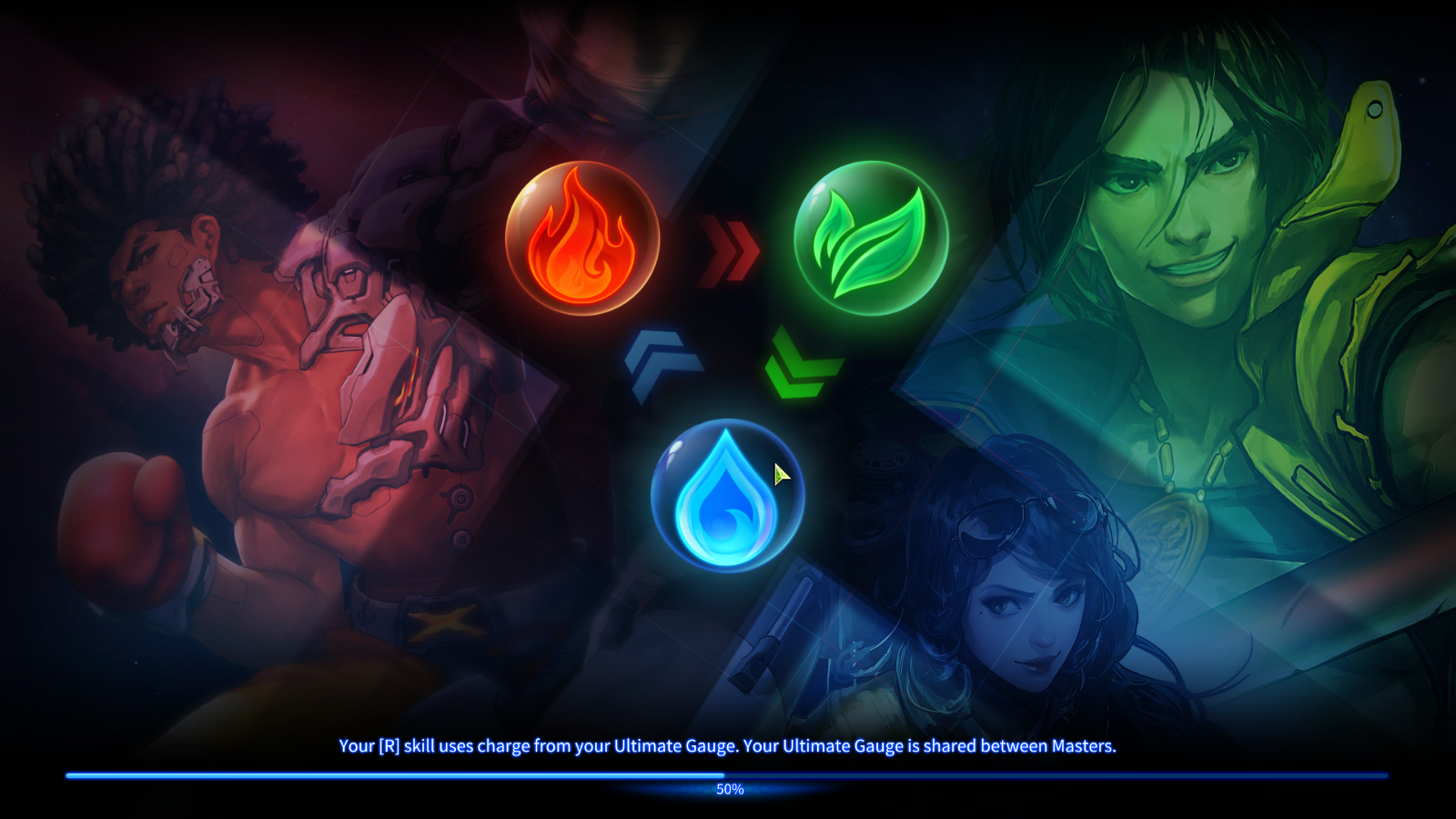
Masters
There are several things to note about the Masters. Firstly, all of the 50 or so playable Masters fall within three attunement types – Helix, Kinetic, and Ardent. Each type has a strength against and a weakness to another type (displayed above). This comes in handy when selecting which Master to use in each mode, as it can provide a tangible advantage in combat. For this reason, it’s important to get a good handle on a variety of Masters — the last thing you want is to get stuck playing a Helix Master in a Kinetic stage because you don’t know any better.
Besides types, Masters are also grouped into another set of categories called Roles. Roles tend to outline a Master’s prime directive on the battle field:
- Assassins like Dr. Raoul are agile and can dive into back lines with ease to burst single targets into dust quickly.
- Assaults like Vonak do consistent damage from a distance, and can be extremely deadly when well protected.
- Juggernauts like Koom are hardy and indomitable survivalists, remaining the center of attention at the front of your pack.
- Marksman like Innowin are lethal from long range, and are the bane of back line Masters’ existence.
- Nukers like Taejin do heavy damage with area of effect abilities.
- Skirmishers like Cagnazzo live for the chaos of melee combat, and thrive deep in the fray.
- Summoners like Arami conjure up minions to do the fighting for them.
- Supports like Bumaro live to serve, protecting and enhancing allies in order to help them do what they do, and do it better than they could without them.
Each individual Master starts with two abilities unlocked, as well as their Ultimate. As you gain resources, other main abilities can be unlocked, although only two can be equipped at any given time. For Stage play, abilities can be upgraded to gain more features like faster cooldowns, more damage, or added effects. They all have Active skills and Survival skills that enhance their playstyles in specific ways, as well. There are also passive Weapon Augments that can be unlocked and upgraded, which alter your basic attacks in some form or fashion. Some increase attack speed, others extend attack ranges, but they all require special types of resources to upgrade, and can only be equipped one at a time. They can be mixed and matched during the Master select screen when dispatching for action.
Quick Tip!: Another piece of equipment can be selected when you pick Masters, Abilities, and Node Pages — Support Kits. When equipped, they trigger automatically when your Master is in trouble in a Stage, activating effects like increasing the power of attacks or healing some damage. They can be found as rewards or bought in the Store, and only one can be equipped at a time.
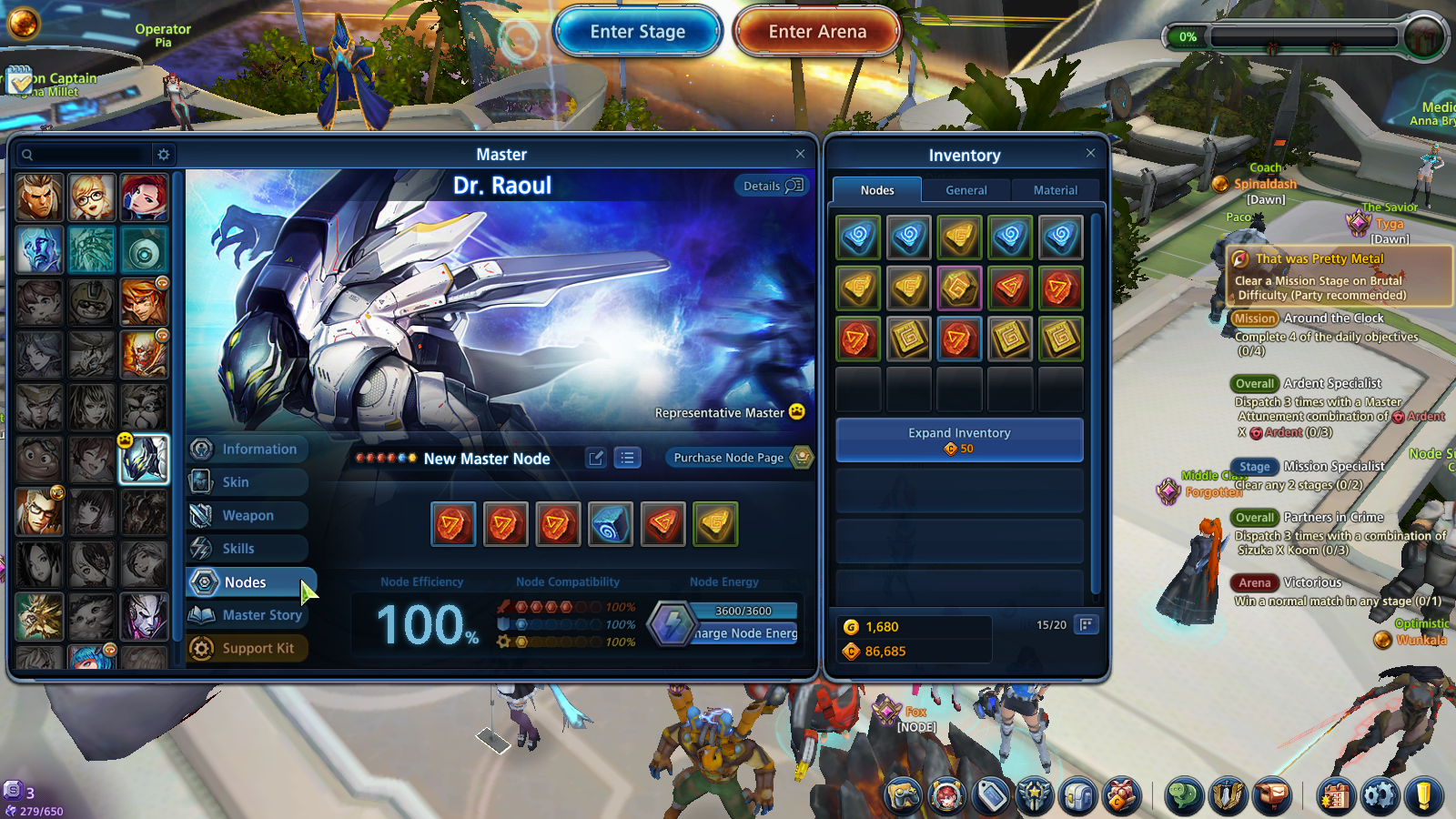
Nodes are another feature that all Masters have access to and they are wildly important to keeping them combat ready. They come in three types:
- Auxiliary nodes are good for increasing the power of your skills, or how well they bypass skill armor.
- Offensive nodes generally increase weapon damage and its ability to penetrate enemy defenses
- Defensive nodes are great for raising health or armor.
All node bonuses are passive, which mean so long as they are equipped, they apply the bonus without any more input from you. Nodes can be purchased from vendors on the Dredgion with gold or X-Coin (found in PvE stages as rewards) or from the Medal Exchange. They are assigned to pages, of which there are a limited number (but more can be purchased). They can be equipped and removed easily, but it’s not possible for one node to occupy a slot on two different pages. Pages can be shared among Masters, and each Master has a particular assortment of nodes that they prefer, known as their Node Compatibility. When efficiency is less than 100%, the equipped nodes are less effective. You can select pre-made pages during the Master select screen when dispatching, the same as with abilities.
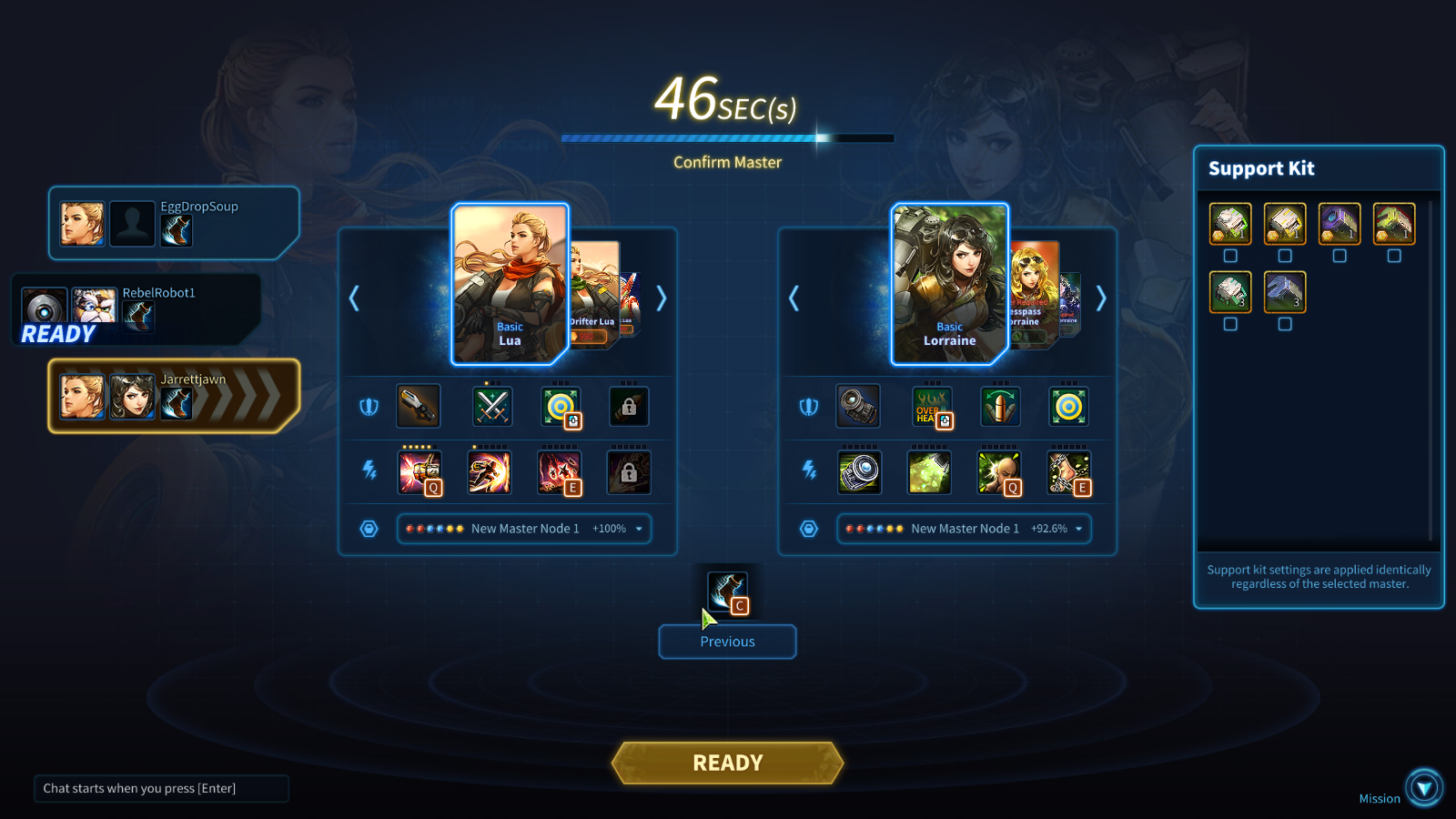
TAG System
In all modes, MxM is a third person action game, where Masters are controlled with mouse and keyboard. Players actually select two characters, and play as both over the course of a game using the TAG System. With a flick of the mouse wheel, Master #1 is replaced by Master #2, and after a short cooldown, they can be tagged back out. As a result, hero selection is imperative, as you want to pick a pair with compatible skills for wombo combos, or two Masters that complement each other’s weaknesses.
Tagging creates a lot of tactical scenarios as well. Masters don’t share a life bar, but if one dies, they both die. This means tagging in and out can be a defensive strategy just as much as it can be used for offense. Tag out to prevent the final hit of an attack — and know that when you commit to certain attacks, you may be taking the enemy’s bait.
Quick Tip!: Tagging our Masters under the effects of crowd control like slows or stuns will clear those effects, allowing the new Master to come in unhindered. Their stamina will take a hit, but this is a good way to mitigate the damage that a well-timed stun can do.
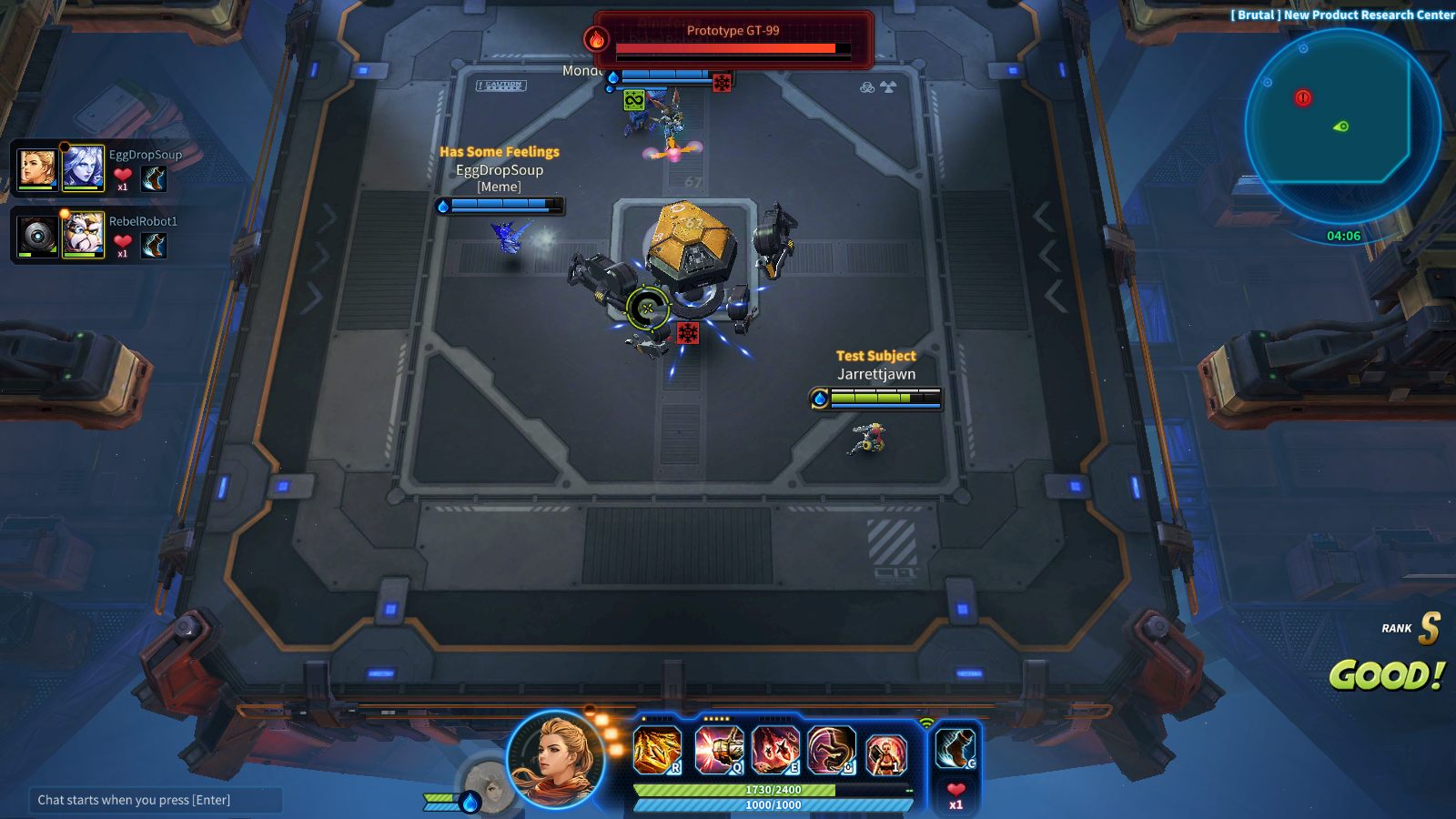
Game Modes
There are three ways to play MxM that are each significantly different to the others; PvE, PvP, and Mini-Games.
Stages
The PvE environments are known as Stages. In these areas, teams of players work together to navigate a dungeon and defeat its denizens. There are five different Stages, each with four difficulty levels that determine the map type and enemies you’ll find therein. Each Stage has an attunement type, just like the Masters, which is important to keep in mind when selecting the right Master for a particular job. With the proper Master selection, and with a well-upgraded, high-efficiency load-out, you’ll be ready for the highest difficulty in no time.
- Caligo Factory (Ardent) is an AI-controlled munitions facility staffed by self-aware robots that have no problem using the weapons they’re building against you.
- Karith (Helix) is home to a primitive, human-like race who have absolutely no love for you or your people.
- Lacrimosa (Kinetic) was once a bustling modern society. As it’s fallen into ruin, the mutants have taken over.
- Nuuran (Helix) is an arid desert world full of mutated wildlife and techno bugs. Poison and slows await your party.
- Rentu Laboratory (Kinetic) houses profane bio-mechanical experiments that conveniently break loose as soon as you arrive on the scene.
Stages are primarily for gaining materials, money, and experience. The better you perform in the Stage, the better your chances of being rewarded with more of those things. Each run through of a Stage is graded with a rank. An S-Rank is the highest you can achieve, and is necessary for maximum rewards AND for unlocking new difficulties. To score better, make sure that you are keeping your hit and kill combos high, not taking too much damage, and finishing the Stage as quickly as possible. Know that your rank is shared among all members of your party, so to succeed with the group, jut remember: teamwork makes the dream work!
Quick Tip!: Each Stage ends with a boss battle. After using big attacks, bosses will be left in a Weak state. Attacking a boss that’s in this state will fill up its break meter. When a break meter is full, the boss is stunned and will take massive damage. When they’re weak, go all out!
The five main Stages are always deployed into randomly unless you have an item called a Dispatch Ticket. So, if you want to choose a specific stage for the items they drop, you’ll need to drop some X-Coins to buy one. There is a special rotating set of Stages accessible via the Timespace Distortion. These Stages are temporary, and provide items and resources that you can’t get normally.
Natium Defense Line is a King of the Hill-style mode where teams of players work together to survive waves of baddies for as long as possible. Monsters that self-destruct will charge the Natium, while other enemies will attempt to prevent you from stopping them. It’s a Nightmare difficulty mode that isn’t available immediately — you need ten Masters unlocked and must be level 35 before even attempting it.
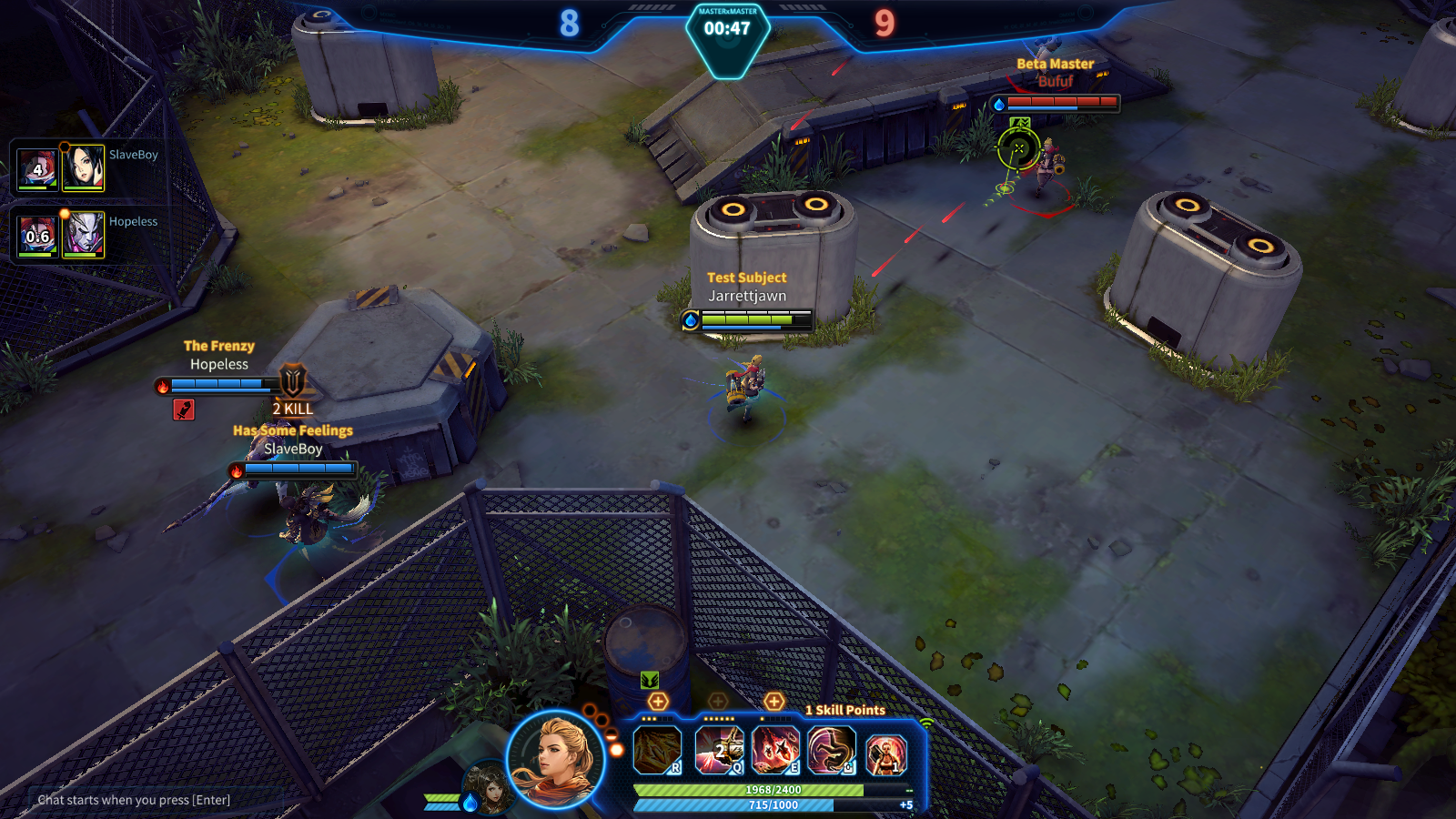
Arenas
The PvP environment is called Arenas. There are two ways to compete against other players in MxM, in Combat Arenas or in the Titan Ruins.
Combat Arenas are small, fast-paced 3v3 scenarios that task teams with getting the most kills in five minutes. There are three different Combat Arenas to do battle in, each with its own quirks.
- Bridge Arena creates random obstacles in the battle space, but attacks can disable them.
- Brush Arena has exactly that — brush. Brush is useful for staying hidden in, and the layout of the arena changes at set intervals.
- Portal Arena is full of teleportation pads that move you across the area with ease. After being used, the portals go on a brief cooldown before they can be accessed again.
In the Combat Arena, your previously leveled abilities don’t apply. You gain experience passively and when scoring kills and assists, which level you up and give you skill points that you can assign to abilities through the course of the match. Your applied nodes are only 50% effective, as well.
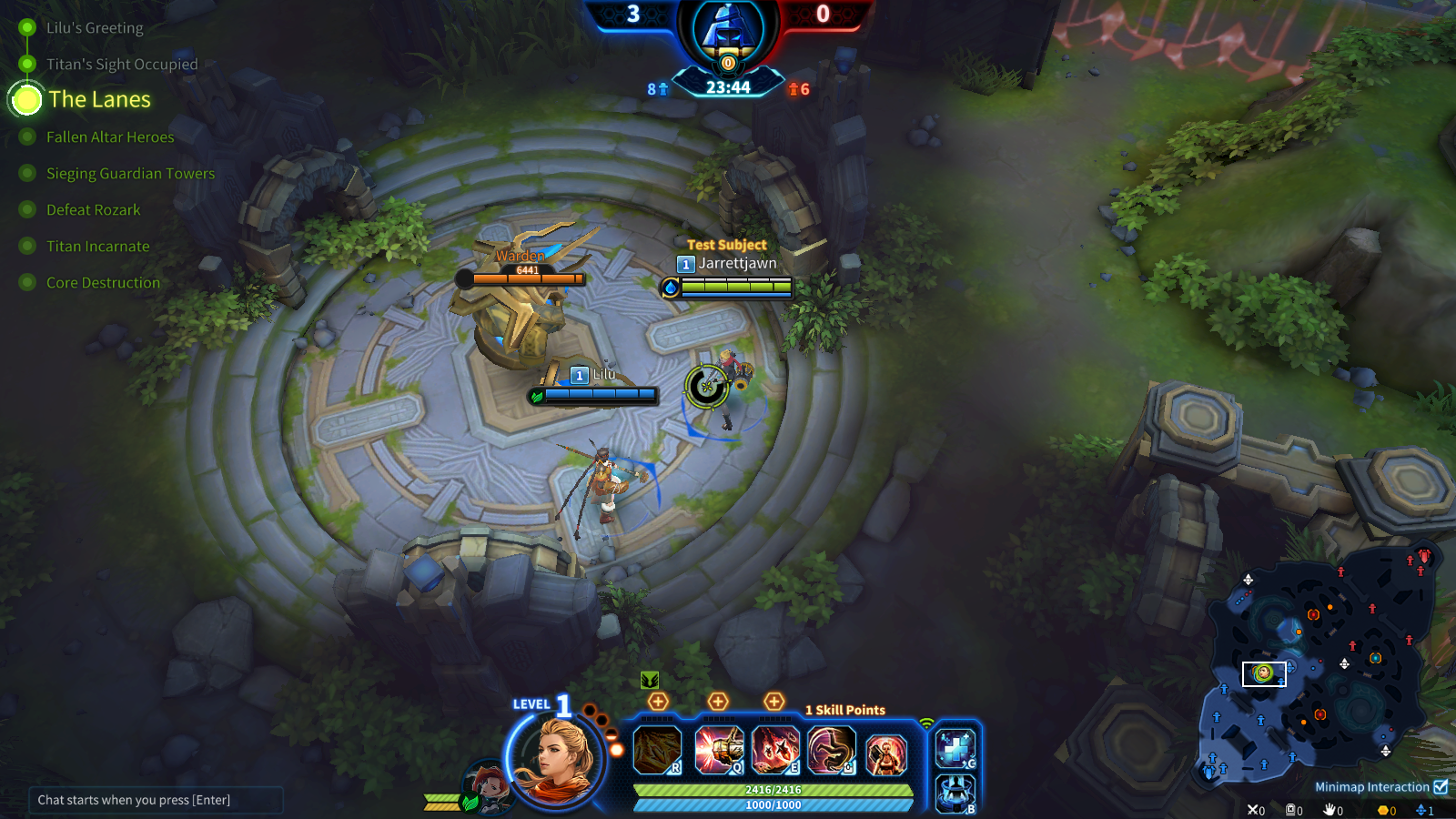
Titan Ruins is a massive 5v5 encounter that most closely resembles the typical MOBA experience. With a heavy focus on objective play, three lanes lead to a core that must be destroyed — but not until the various towers and enemies in the way are dispatched. Unlike those other MOBAs, though, there are a couple other ways to win the game. If you can’t destroy the core, you can claim victory by reaching the score limit of 1000 points before the other team. If no one destroys a core or reaches 1000 points within the 30 minute time limit, then the highest score wins. How do you score points? Great question!
- Masters kills provide 8 points.
- Kill assists provide 2 points.
- Defeating a Guardian Captain provides 2 points.
- Defeating a Guardian provides 2 points.
- Defeating Adaman or Ruak provides 10 points.
- Defeating an Altar Watcher provides 2 points
- Defeating an enemy Titan provides 5 points * times killed.
- Defeating a summoned Guardian provides between 75 to 100 points.
- Destroying a Guardian Tower provides 10 points.
- Capturing a Titan Sight provides 3 points.
Every time a team accrues 100 points, a Titan will spawn on their side of the board. Titans are giant creatures who trudge down the middle lane and do massive damage to structures. Titans come in three forms that are aligned with specific attunements, spawn in random order, and cannot be controlled by any player.
- Helix Damizhra increases your team’s defense and boosts health regeneration.
- Ardent Tsaphon grants your team lifesteal and increased stamina regeneration.
- Kinetic Marahv reduces your team’s skill cooldowns provides mana regeneration.
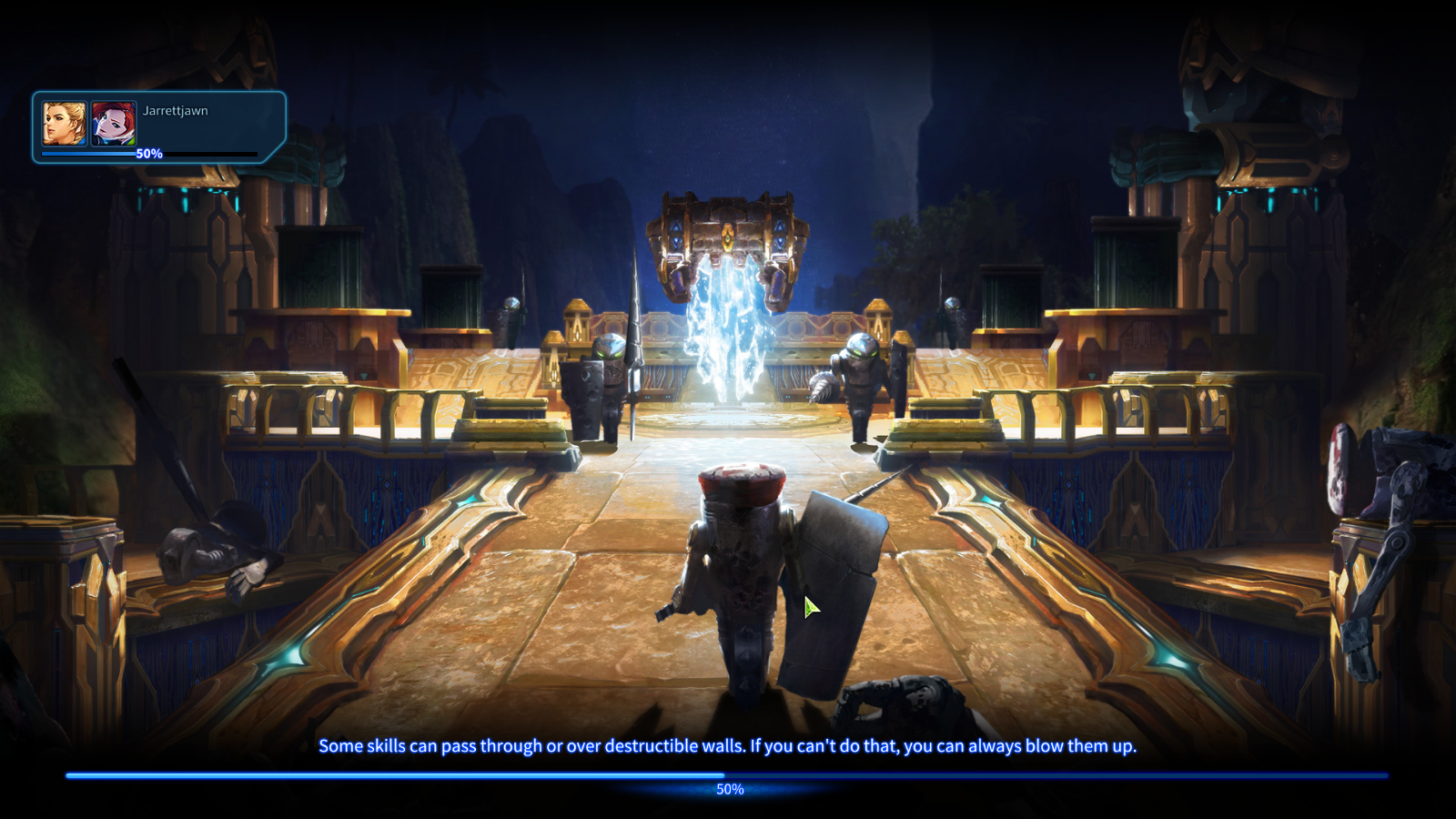
When Titans die, they have unique death effects, which you’ll need to take into account. They also leave a Titan shard when they’re killed off, which can be picked up by players. When you have enough shards, a player on your team can actually transform into a Titan Incarnate, which gives them a new set of devastating attacks and makes them a near-unstoppable force for a short time.
Quick Tip!: Like Bosses, Titans will fall into the Weak state, and can be broken, stunned, and incur massive damage in the same way.
Like Combat Arenas, your upgraded abilities don’t apply here — you upgrade your abilities as you play the match, leveling up and growing in strength by playing well and amassing experience. On top of those abilities, you also gain Traits every three levels, which serve to further enhance particular stats of your Masters. Nodes are only 50% effective in the Titan Ruins.
Master Mini Games are wacky and straightforward party games that test your skills at platforming, obstacle dodging, and shooting on the run. Games like Jump Rope and Bullet Hell Survival really put your fingers to the test. They’re small and score based, and they’re a nice change of pace from long stints in Arenas or Stages.
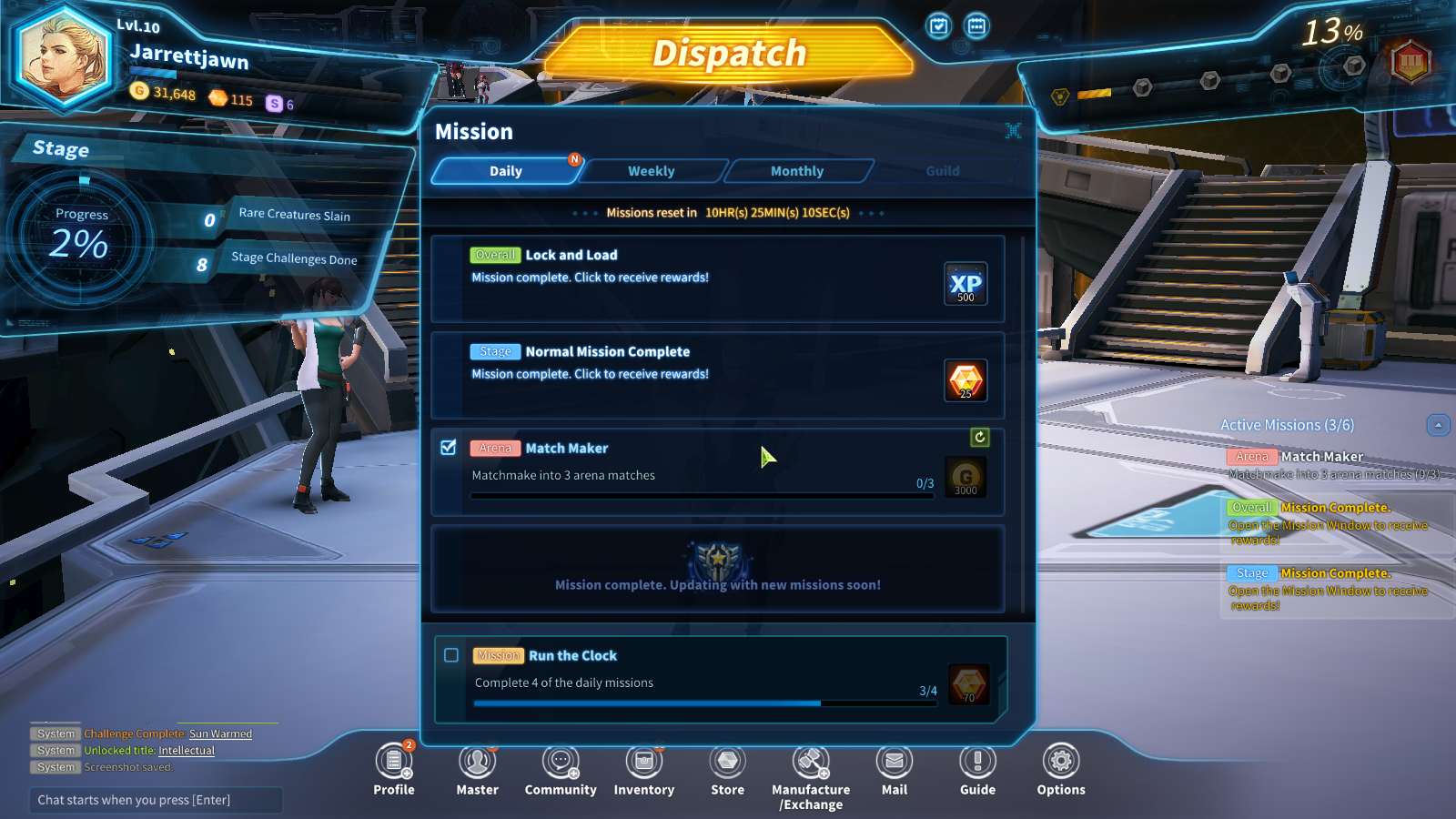
General Early Game Tips
- The moment you start up MxM for the first time, the game will prompt you to start a string of Tutorial Missions. DO NOT IGNORE THESE! Not only do they show you how to play the game, but they reward you with some sweet materials to advance through those early upgrades quickly.
- Pick a main Master as soon as possible. Focus on getting them well upgraded and equipped ASAP. A good choice for this is Lua, who you spend much of the Tutorial missions with anyway.
- It may be worth expanding your range of Masters across the three attunements after getting your main Master to a comfortable level. A solid Ardent like Koom and lethal Helix like Sizuka means you’ll always be able to take advantage of a Stage’s weakness when it comes time.
- Save your SOL and X-Coins, as you’ll be getting plenty of both as rewards at early levels You’ll want to have enough to spend it on the things you’ll really need when you start to understand what they are.
- Do your dailies. The rewards are worth it and, generally speaking, they aren’t hard to complete.
- Look into getting into a Guild early, as you can gain bonus rewards simply for being in one.
- Get yourself a third Node page pronto. Many Masters’ efficiency requirements differ drastically from one another.
With this basic information squared away, you should have everything you need to get tagging and taking down your foes competently. For more information, head to the Official Master X Master Wiki!
